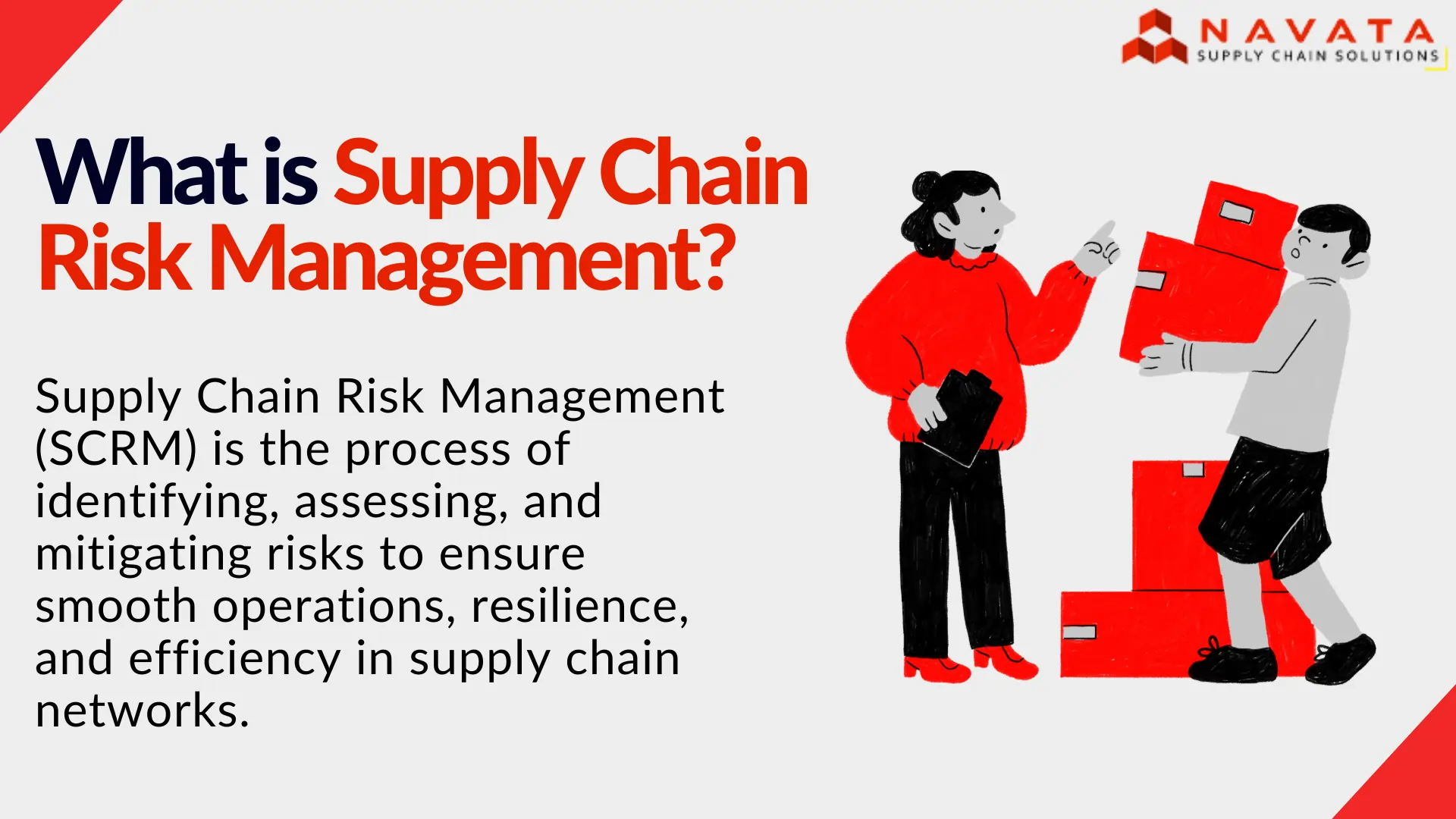Supply Chain Risk Management
Supply Chain Risk Management (SCRM) helps businesses detect and analyze, and reduce threats which block the uninterrupted movement of products along their delivery routes. Modern business operations run global supply chains that are increasingly complex and interconnected, yet they remain exposed to numerous types of disruptions.
The major supply chain risks derive from operational failures among suppliers, workforce shortages, financial currency instabilities, price variability and cybersecurity threats, including data breaches and hacking incidents in combination with environmental risks, including natural disasters, geopolitical instabilities, and regulatory changes. Businesses which execute strong risk management approaches develop better resilience levels while maintaining operational performance along with keeping loss amounts minimal.
Supply Chain Risk Management (SCRM) represents a purposeful method which helps organizations detect and evaluate and reduce possible interruptions that disrupt supply chain operations. Organizations actively plan ahead to sustain operations and reduce money loss and support customer expectations.
Companies that recognize their risks in advance can predict future threats that include supplier breakdowns and manufacturing delays as well as cyberattacks and regulatory changes. The identification of risks helps companies determine their potential effects, which leads to the creation of contingency plans. The stability of supply chains becomes possible through risk mitigation strategies which include using multiple suppliers and embracing technology, as well as establishing strict compliance practices.

You May Also Like to Read: 7 Major Supply Chain Risks Companies Encounter and Solutions
Key Risks in Supply Chains
Operational Risks
The flow of goods and services faces interference from operational risks that stem from manufacturing interruptions, supplier breakdowns, and employee staff shortages. The operations suffer from delays caused by raw material acquisition problems, combined with equipment malfunctions and employee walkouts, which drive up expenses and produce unhappy customers. A business needs to implement strong contingency measures and diversify suppliers and manage its workforce effectively to protect against these operational threats.
Financial Risks
A company’s financial performance faces substantial damage from currency exchange risks combined with unpredictable costs and supplier bankruptcy events. Targeted business sectors find their international trade operations impacted by currency exchange variations and they face rising operational costs due to shifting fuel prices and material costs. The financial problems of important suppliers create a risk that disrupts the flow of materials through the supply network. Evaluating financial risks requires companies to establish effective planning methods combined with adaptable pricing approaches and procedures to assess credit risks.
Cybersecurity Risks
Digitalization of supply chains has resulted in rising threats from cyber attacks which include data theft and ransomware incidents together with hacking attempts. Digital security breaches result in the loss of sensitive information that both damages business operations and creates financial damages. Companies should build robust cybersecurity protocols and conduct regular system updates together with employee training about data protection methods to guarantee supply chain network security.
Natural and Geopolitical Risks
Business supply chains experience significant threats when faced with environmental changes and natural emergencies and geopolitical disturbances. Natural occurrences together with earthquakes and floods and hurricanes frequently destroy transportation links and delay deliveries and break down infrastructure. Various political conflicts coupled with trading limits coupled with regulatory changes affect the functioning of supply chains. The unpredictability of these external risks necessitates that businesses perform risk assessments while choosing suppliers from different geographical areas and creating backup plans for such emergencies.
You May Also Like to Read: What is Supplier Relationship Management (SRM)?
Benefits of Supply Chain Risk Management
Improved Resilience and Agility
A supply chain that receives proper management becomes better able to resist disruptions which enables companies to react swiftly to unexpected challenges. Companies that identify risks beforehand together with proactive strategy implementation reduce both production slowdowns and operational stoppages so they operate without interruption during emergency situations. A rapid supply chain response system enables businesses to handle market transformations along with regulatory and supplier disruption changes without encountering major disruptions.
Cost Savings and Operational Efficiency
Risk management techniques enable organizations to cut down their financial expenses from disruptions that affect their supply chain. The combination of supplier diversity with inventory optimization alongside technological implementation enables businesses to decrease waste costs along with transportation expenses while bypassing high-priced emergency acquisitions. Technology tools boost organizational efficiency through automated systems that eliminate manual activities in business processes.
Stronger Customer Trust and Brand Reputation
A business becomes successful when it handles its supply chain effectively because its better management results in prompt deliveries and high-quality products and dependable customer services. Businesses that demonstrate robust resilience in disruption management create improved brand loyalty and trust from their customers. A combination of strong brand reputation together with reliable supply chain management provides businesses with greater market competition power.

Strategies for Effective Supply Chain Risk Management
Risk Identification and Assessment
Effective supply chain risk management starts by identifying potential threats, followed by their proper assessment. Risk mapping, predictive analytics and regular audits function as business tools for detecting vulnerabilities. The combination of risk mapping provides visual weaknesses identification alongside predictive analytics which utilizes data assessments for predicting disruptions in advance. Audits that occur at regular intervals help to detect when suppliers and internal processes do not follow industry standards, thus reducing unexpected risks.
Diversification and Supplier Management
A company becomes more vulnerable to disruptions whenever it depends on only one supplier base or manufacturing hub. A multi-sourcing strategy involving multiple suppliers extends business flexibility by lowering vulnerability to supplier dependency. The success of risk mitigation heavily depends on maintaining strong relationships with suppliers. By establishing open communication lines and performing routine performance evaluations as well as partnering with suppliers for extended periods, businesses acquire both reliable and flexible supply chain operations.
Technology and Automation
Supply chain risk management receives transformative benefits from three advanced technologies, which include Artificial Intelligence (AI), Blockchain, and Internet of Things (IoT). Through AI analytics companies achieve accurate predictions of market shifts, and they can recognize irregularities within their supply network. The implementation of Blockchain technology protects transaction records while simultaneously minimizing fraud occurrences in supply systems. By deploying IoT sensors, businesses can track their goods’ real-time conditions during transportation, which provides better logistics oversight while cutting down risks of destruction or losses.
Planning and Resilience Building
Preventive measures cannot eliminate every potential disruption that might happen. Companies need to develop response plans and continuity strategies which allow them to achieve quick business recovery. Businesses need to keep safety stocks on hand and develop alternative delivery paths as well as standby supplier networks. The adaptation of challenges by a resilient supply chain system enables business operations to stay smooth and uninterrupted.
Manage Your Supply Chain Risk with Experts!
Conclusion
Supply Chain Risk Management (SCRM) is essential for ensuring stability, efficiency, and resilience in today’s complex and interconnected global supply chains. By identifying and mitigating risks such as operational disruptions, financial uncertainties, cybersecurity threats, and geopolitical instabilities, businesses can minimize losses and maintain seamless operations.
Effective SCRM strategies, including diversification, technology adoption, and contingency planning, enhance agility and reduce vulnerabilities. Organizations that proactively manage supply chain risks benefit from cost savings, improved customer trust, and a stronger market position. Investing in robust risk management practices is key to sustaining long-term business success in an unpredictable environment.
Thanks For Reading: What is Supply Chain Risk Management?
Powered By 360Presence

